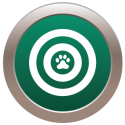Wit~Wit: Text Instruction
Goal: The cue Wit-Wit means drive to my side and stay in position until you stop the continuous cue. This cue is used when you need your dog to come off the most obvious piece of equipment and carry on to the correct piece of equipment. The ultimate use in agility for this cue is for negotiating around tight courses and helpful in the agility game Snooker.
Equipment: Treats and a toy for building arousal. Soft sided crate.
Suggested Training Area Size: 6' x 6' (2m x 2m)
Step 1: Have one cookie in your hand, with your dog informally in your reinforcement zone, shake your hand (or slap your leg) and present a cookie this is the initial value building/cue building stage. Because you have a physical cue working together you can add the verbal cue right away.
Note: For a physical cue you may also choose to slap your leg instead of shaking your hand. Both are acceptable cues to use. As for a verbal cue we use Wit-Wit because for our dogs it is a shortened cue of “with me.” You may use any cue you wish.
Step 2: Add your movement of walking, then running while shaking your hand and saying your new cue “wit~wit”. This is the value building stage.
Step 3: Add a distraction like a kennel with the door closed or an empty food bowl. Cue your “wit~wit” as you pass by. What is the dog’s choice. Is the value with your new cue or the distraction. (Value building)
Step 4: Progress to adding a bigger more inviting distraction like your crate door open. Work up to having the dog differentiate between “get in the kennel” and “wit wit” cues. (Value testing)
IMPORTANT: Remember to work straight as well as turning with your wit wit game. It is important to not always get in the habit of turning when you “wit wit” because it should also mean to run by obstacles as you run by straight. We find in training students turn to help the dog come off of obstacles but it is important to balance running straight and turning when you practice “wit~wit”. Shoulders must point forward. It is a common mistake to open up and drop the shoulder to see the dog but by pointing forward you will know the dog is staying with you on the physical and verbal cue alone and will be able to move forward fast as you run past the obstacles you do not want the dog to take.
Troubleshooting
If your dog is struggling with this exercise practice daily around the house. Place a dinner dish or a toy in an obvious place and then “wit~wit” past. You will be adding value to the cue at this stage. Adding creative distractions every day.



Susan
Say Yes Team
Leave a comment below or click here to view the lesson.